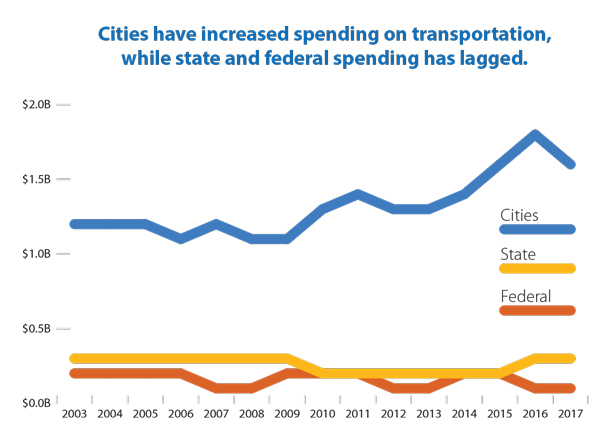Transportation
Cities are investing more than ever in transportation infrastructure, but can’t close the $1 billion gap in maintenance and preservation costs
Cities own, manage, and maintain a significant share of our state’s transportation system. More than a quarter of all daily trips happen on city streets. And, while cities are investing more than ever before, they are struggling to address the $1 billion funding shortfall that exists in maintenance and preservation costs. In addition, cities face a $900 million gap in unmet transportation system growth needs, including city streets that are designed for the transportation modes of the future—those that will transport people for their first or last mile.
75% of cities list transportation maintenance as one of the top three significant capital budget needs. For a quarter of those cities, it ranks as the number one need.
Cities need greater local options and more state-shared resources to fully address transportation shortfalls
For city transportation systems to thrive, cities need:
- Protection of existing transportation revenues and creation of more local revenue options.
- Policy improvements like the expansion of Transportation Improvement Board programs, a federal fund swap option, and other changes to existing policies and programs.
- A state transportation revenue package that increases resources for cities.
25% of daily trips happen on city streets, yet cities receive only 8% of the state transportation budget.
Transportation maintenance ranks as a top city budget need
Three-quarters of cities name transportation maintenance as one of the top three capital budget needs. For a quarter of those cities, street improvement and repair rank as the number one need. Similarly, nearly two-thirds of cities say maintenance is their greatest transportation need.
A recent study by the state’s Joint Transportation Committee found that cities have stepped up to invest in their local transportation systems—providing nearly 80% of city transportation funding from local revenue. But while cities have increased their investment, state and federal government investments have declined at the same time. The result is a $1 billion per year maintenance and preservation funding gap. The costs of preservation and maintenance continue to outpace local revenues—creating a costlier backlog over time.
Most cities are unprepared for the rapid rise of alternative transportation modes, such as autonomous vehicles and micromobility devices (scooter and bike shares), which may require additional investments.
The amount of state funding for city streets does not match their level of use
Cities are responsible for more than a quarter of the roadways that make up the state’s transportation system. Most trips begin and end on city streets. City streets are an essential and basic part of our transportation network, connecting Washington residents and communities, and supporting our economy. While more than 25% of statewide travel occurs on city streets, cities only receive 8% of the state’s transportation investment.
Washington cities spent $1.4 billion in construction, maintenance, and preservation projects in 2017.
City streets interact with both the built and natural environments. This means streets must allow for utility infrastructure, residential and commercial uses, trees, and multiple users of various transportation methods—such as cyclists, transit riders, pedestrians, and people requiring accessible sidewalks. Cities have stepped up to invest local dollars in their streets; but as the complexities increase, so do the costs to maintain city roadways. City streets are a vital part of the state’s transportation system and require increased state investments to address systemwide mobility needs.

Cities rely on state resources for basic maintenance and preservation. Yet state investment has remained unchanged, or even declined, during the last 15 years.
Regional differences
While cities generate most of their transportation resources locally, they also rely on state-shared revenues to bolster their local spending. The Transportation Improvement Board (TIB) provides small cities (under 5,000 in population) with an asset management and pavement preservation program. TIB also provides grants to larger cities (over 5,000 in population) to fund or partially fund vital infrastructure projects. Unfortunately, greater funding is needed, as less than 40% of TIB grant applications were funded for fiscal year 2020.
Most cities are unprepared to meet the needs of new transportation methods
As a result of the strain a growing population puts on transportation networks, micromobility technologies have recently taken off in some cities. Micromobility is a category of very small (usually one passenger) light mode of transportation, such as dockless bikes and electric scooters. Micromobility provides new ways for residents to move throughout a community. The promise of this alternative transportation method is to close the public transportation gap between the first and last mile of trips—making investments in public transit more effective and reducing congestion.
The rapid rise of micromobility comes with an additional set of challenges and considerations for local decisionmakers. Three-quarters of cities say they are unprepared for micromobility. Many cities are already feeling the pressure of adapting to the rapid rise of micromobility technologies. And almost all cities feel unprepared for the rise of autonomous (driverless) vehicles.
Prioritizing multimodal goals without raising additional or dedicated funding affects a city’s foundational street responsibility—maintaining and preserving existing infrastructure to protect the city’s investment. There are also important safety and liability considerations when sidewalks and bike lanes become crowded and more complex. Balancing these competing, but often compatible, interests is increasingly challenging.
Conclusion
City responsibilities for streets come with many considerations, including how to accommodate multimodal transportation goals, how to increase access for individuals with differing abilities, and how to smoothly manage the complexities of the built and natural environments. Construction costs, inflation, and competition for increasingly scarce local revenue reduce resources available to invest in maintaining city transportation infrastructure. When cities can’t invest enough in preserving the existing system, lifecycle costs compound over time—creating a costlier system for all users.
Next chapter: Affordable housing & homelessness